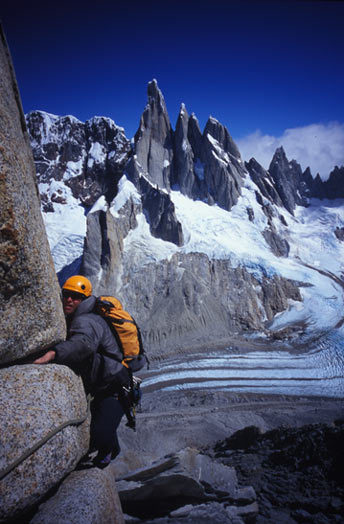
Paul McSorley on the first free ascent of Aguja Rafael Juarez?s complete West Ridge (5.10d A1, 24 pitches, Crouch-Donini, 1994). McSorley and Jon Walsh climbed the route at 5.10+ in a big day from the Pollacos camp. The pair also made the first ascent of The Canadian Route (5.10 A1, 900m [500m new]) on Fitz Roy; Walsh soloed the new route Comono (5.10 A1, 500m [240m new]), also on Aguja Rafael Juarez; and he teamed up with Andres Zeger and Isaac Cortes to climb Dieta Del Legarto (5.11+ A1+, 700m), a variation of El Facon on Aguja Desmochada?s south face. [Photo] Jon Walsh
Paul McSorley and I rolled into Patagonia at the end of January, just in time for the start of three weeks of mostly excellent climbing weather. We immediately hiked to Paso Superior, intending to find an unclimbed line on the south or east face of Fitz Roy. After seven sweet early-morning pitches up La Brecha, we saw an obvious line of beautiful clean corners splitting the south face, just left of the Boris Simoncic Route (ED-: 5.9 A2 55 degrees, 650m, Biscak-Fadjan-Lenarcic, 1985). Dropping down about 100 meters from the col, we crossed the ‘shrund and found an easy mixed ramp that shared the first forty meters of the Boris, then followed another ropelength to the first beautiful corner. We started short-fixing, mostly climbing in boots and aiders because of the ice on the ledges and the numbness of our fingers. The second pitch turned out to be the technical crux with a section of about eight meters of thin Stoppers that would probably go free at 5.12. A couple of pitches later, a short 5.9 squeeze behind a flake led to one of the best corners we had ever climbed. Another nice thirty-meter corner and some easier terrain brought us to a ledge where we had a comfortable bivy. The rest of the route followed a 5.10 ramp system below a steep wall on the left, and exited up a short offwidth to the summit slopes. We summited under calm, clear skies, and rappelled the Franco-Argentine, disgusted by the amount of trash on that route. We called our climb The Canadian Route (5.10 A1, 900m [500m new]); Aaron “The Need for Speed” Martin and Jacob Schmitz (US) soon repeated it in seven hours from the ‘schrund to the summit, with Martin leading every pitch and freeing about eighty-five percent of it at 5.10 or easier. They also confirmed the route’s quality; we all thought it would be a better alternative at around the same overall grade as the Franco-Argentine.
In the following weeks Paul and I managed the first free ascent of Aguja Rafael Juarez’s complete West Ridge (5.10d A1, 24 pitches, Crouch-Donini, 1994) at 5.10+ in a big day from the Pollacos camp. A week later, Paul twisted his knee, so I rope-soloed a new route on the north face of Rafael. After we fixed two ropes during a couple of false starts, the weather stabilized, and I climbed 240 meters of new ground, up beautiful clean cracks on the right side of an obvious red pillar before joining Artibelleza (6c, 400m). From the top of the pillar, a difficult left-leaning corner–the crux (5.11+) of the route–splits the headwall. Eventually I intersected the Piola-Anker route (ED-: 5.11a, 450m, Anker-Piola, 1989) and contoured onto the east face before completing the final two ropelengths to the summit, where a few yodels ensued between myself and some friends on St. Exupery. A smooth descent down the Anglo-American Route landed me safely back at camp by dark. Comono (5.10 A1, 500m [240m new]) is a good contender for a free ascent, with mostly high-quality, sustained moderate crack climbing and a few sections of spice.
I then joined Andres Zeger (Chili) and Isaac Cortes (Catalonia) to make a new variation to El Facon (V+ 5.12a A1, 16 pitches, Bowers-Bransby-Tresch, 2004) on Aguja Desmochada’s south face. Our variation, Dieta Del Legarto (5.11+ A1+, 700m), starts just left of El Facon and climbs the lower tier in five pitches before traversing the horizontal break to the right and joining El Facon for two long pitches. It then goes into the big, overhanging, left-facing corner (just before El Facon goes through the sickle roof) for about three beautiful new pitches before joining El Facon again for all the offwidths and squeeze chimneys, which we climbed in the dark. We topped out at 10 a.m. the next morning after climbing through the night. We rapped the route, arriving back at the Polacos bivy thirty-six and a half hours after leaving it.
— Jon Walsh, Golden, British Columbia, Canada